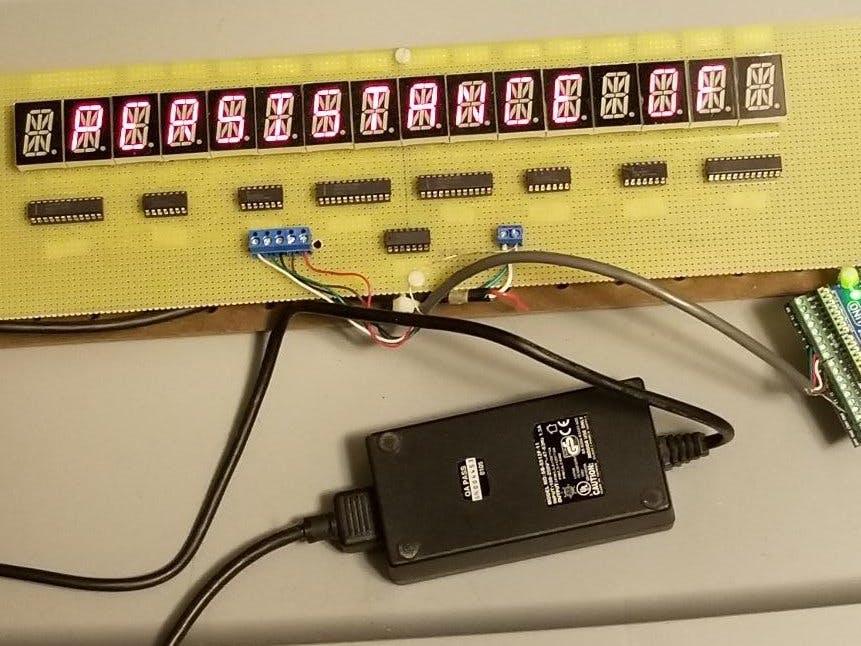#include <avr/pgmspace.h>
#include <stdlib.h>
const int NUMBER_OF_ELEMENTS = 96;
const int MAX_SIZE = 10;
const char OSeg [NUMBER_OF_ELEMENTS] [MAX_SIZE] PROGMEM = { //Outer Segment Codes
{"00000000"}, //
{"00000000"}, //
{"00000000"}, //
{"00000000"}, //
{"00000000"}, //
{"00000000"}, //
{"00000000"}, //
{"00000000"}, //
{"00000000"}, //
{"00000000"}, //
{"00000000"}, //*
{"00000000"}, //+
{"00000000"}, //
{"00000000"}, //-
{"00000000"}, //
{"00000000"}, ///
{"00111100"}, //0
{"00011000"}, //1
{"00110100"}, //2
{"00111100"}, //3
{"00011000"}, //4
{"00101100"}, //5
{"00101100"}, //6
{"00111000"}, //7
{"00111100"}, //8
{"00111100"}, //9
{"00000000"}, //
{"00000000"}, //
{"00000000"}, //
{"00000000"}, //
{"00000000"}, //
{"00000000"}, //
{"11110111"}, //@
{"11111001"}, //A
{"01111110"}, //B
{"11100111"}, //C
{"01111110"}, //D
{"11100111"}, //E
{"11100001"}, //F
{"11101111"}, //G
{"10011001"}, //H
{"01100110"}, //I
{"00011111"}, //J
{"10000001"}, //K
{"10000111"}, //L
{"10011001"}, //M
{"10011001"}, //N
{"11111111"}, //O
{"11110001"}, //P
{"11111111"}, //Q
{"11110001"}, //R
{"11101110"}, //S
{"01100000"}, //T
{"10011111"}, //U
{"10000001"}, //V
{"10011001"}, //W
{"00000000"}, //X
{"10011110"}, //Y
{"01100110"}, //Z
{"00100100"}, //[
{"00000000"}, //\
{"01000010"}, //]
{"00000000"}, //^
{"00000110"}, //_
{"00000000"}, //`
{"00000111"}, //a
{"10000011"}, //b
{"00000011"}, //c
{"00000011"}, //d
{"00000011"}, //e
{"00100000"}, //f
{"11000010"}, //g
{"10000001"}, //h
{"00000000"}, //i
{"00000011"}, //j
{"00000000"}, //k
{"00000000"}, //l
{"00001001"}, //m
{"00000001"}, //n
{"00000011"}, //o
{"11000001"}, //p
{"11000000"}, //q
{"00000001"}, //r
{"11000010"}, //s
{"10000011"}, //t
{"00000011"}, //u
{"00000001"}, //v
{"00001001"}, //w
{"00000000"}, //x
{"10000010"}, //y
{"00000010"}, //z
{"00100100"}, //{
{"00000000"}, //|
{"01000010"}, //}
{"00000000"}, //~
{"00000000"}, //
};
const char ISeg [NUMBER_OF_ELEMENTS] [MAX_SIZE] PROGMEM = { // Inner Segment Codes
{"00000000"}, //
{"00000000"}, //
{"00000000"}, //
{"00000000"}, //
{"00000000"}, //
{"00000000"}, //
{"00000000"}, //
{"00000000"}, //
{"00000000"}, //
{"00000000"}, //
{"11111111"}, //*
{"10100101"}, //+
{"00000000"}, //
{"10000001"}, //-
{"00000000"}, //
{"00010010"}, ///
{"00100100"}, //0
{"00010000"}, //1
{"10000100"}, //2
{"10000000"}, //3
{"10100000"}, //4
{"10100000"}, //5
{"10100100"}, //6
{"00000000"}, //7
{"10100100"}, //8
{"10100000"}, //9
{"00000000"}, //
{"00000000"}, //
{"00000000"}, //
{"00000000"}, //
{"00000000"}, //
{"00000000"}, //
{"10100000"}, //@
{"10000001"}, //A
{"10100100"}, //B
{"00000000"}, //C
{"00100100"}, //D
{"00000001"}, //E
{"00000001"}, //F
{"10000000"}, //G
{"10000001"}, //H
{"00100100"}, //I
{"00000000"}, //J
{"00011001"}, //K
{"00000000"}, //L
{"01010000"}, //M
{"01001000"}, //N
{"00000000"}, //O
{"10000001"}, //P
{"00001000"}, //Q
{"10001001"}, //R
{"10000001"}, //S
{"00100100"}, //T
{"00000000"}, //U
{"00010010"}, //V
{"00001010"}, //W
{"01011010"}, //X
{"10000001"}, //Y
{"00010010"}, //Z
{"00100100"}, //[
{"01001000"}, //\
{"00100100"}, //]
{"00001010"}, //^
{"00000000"}, //_
{"01000000"}, //`
{"00000101"}, //a
{"00000101"}, //b
{"00000001"}, //c
{"00100101"}, //d
{"00000011"}, //e
{"10100101"}, //f
{"00100101"}, //g
{"00000101"}, //h
{"00000100"}, //i
{"00100100"}, //j
{"00111100"}, //k
{"00100100"}, //l
{"10000101"}, //m
{"00000101"}, //n
{"00000101"}, //o
{"00100001"}, //p
{"00100101"}, //q
{"00000001"}, //r
{"00000101"}, //s
{"00000001"}, //t
{"00000100"}, //u
{"00000010"}, //v
{"00001010"}, //w
{"01011010"}, //x
{"00100101"}, //y
{"00000011"}, //z
{"00100101"}, //{
{"00100100"}, //|
{"10100100"}, //}
{"10010011"}, //~
{"00000000"}, //
};
#define Interval_Message 1200
#define MAX7219_DATA 5
#define MAX7219_CLOCK 7
#define MAX7219_LOAD 6
#define LdInner 9
#define LdOuter 8
unsigned long time1 = 0; // timer function
int x = 0; // message counter
// Various 16 character strings to display
const char string_0[] PROGMEM = " PERSISTANCE OF ";
const char string_1[] PROGMEM = " VISION DEMO ";
const char string_2[] PROGMEM = "USES Arduino Uno";
const char string_3[] PROGMEM = " Some AND gates ";
const char string_4[] PROGMEM = "MAX7219 and 16- ";
const char string_5[] PROGMEM = "Segment displays";
const char string_6[] PROGMEM = " ";
// Load the above strings into progmem
const char *const string_table[] PROGMEM = {string_0,string_1,string_2,string_3,string_4,string_5,string_6};
char buffer[17]; // 16 characters + 1 null
void initialize()
{
pinMode(MAX7219_LOAD,OUTPUT);
pinMode(MAX7219_CLOCK,OUTPUT);
pinMode(MAX7219_DATA,OUTPUT);
pinMode(LdInner,OUTPUT);
pinMode(LdOuter,OUTPUT);
digitalWrite(MAX7219_LOAD,LOW);
digitalWrite(LdInner, LOW);
digitalWrite(LdOuter,LOW);
}
// -------------------------------------------------------------------------------------------------------------------------------------------
void OuterSegments(byte address, word data) // Note: the 'data' is 16 bits which are split into highByte (for U6) and lowByte (for U2)
{
digitalWrite(LdOuter, HIGH); // AND Gate U1 sections A (clock signal) and D (load signal)
shiftOut(MAX7219_DATA, MAX7219_CLOCK, MSBFIRST, address); // U2 first gets the high byte (Upper 8 Displays Outer Segments) from the UNO
shiftOut(MAX7219_DATA, MAX7219_CLOCK, MSBFIRST, highByte(data));
shiftOut(MAX7219_DATA, MAX7219_CLOCK, MSBFIRST, address); // U2 now shifts the high byte into U6 while U2 gets the low byte (Lower 8 Displays Outer Segments)
shiftOut(MAX7219_DATA, MAX7219_CLOCK, MSBFIRST, lowByte(data));
digitalWrite(MAX7219_LOAD, HIGH); // Load U2 and U6
digitalWrite(MAX7219_LOAD, LOW);
digitalWrite(LdOuter, LOW);
}
void InnerSegments(byte address, word data) // Note: the 'data' is 16 bits which are split into highByte (for U9) and lowByte (for (U5)
{
digitalWrite(LdInner, HIGH); // AND Gate U1 sections B (clock signal) and C (load signal)
shiftOut(MAX7219_DATA, MAX7219_CLOCK, MSBFIRST, address); // U5 first gets the high byte (Upper 8 Displays Inner Segments) from the UNO
shiftOut(MAX7219_DATA, MAX7219_CLOCK, MSBFIRST, highByte(data));
shiftOut(MAX7219_DATA, MAX7219_CLOCK, MSBFIRST, address); // U5 now shifts the high byte into U9 while U5 gets the low byte (Lower 8 Displays Inner Segments)
shiftOut(MAX7219_DATA, MAX7219_CLOCK, MSBFIRST, lowByte(data));
digitalWrite(MAX7219_LOAD, HIGH); // Load U5 and U9
digitalWrite(MAX7219_LOAD, LOW);
digitalWrite(LdInner, LOW);
}
void CmdO(byte address, byte data) // these are U2 and U6 Control Register Commands (data is 8 bits)
{
digitalWrite(LdOuter, HIGH); // AND Gate U1 sections A (clock signal) and D (load signal)
shiftOut(MAX7219_DATA, MAX7219_CLOCK, MSBFIRST, address); // U2 first gets the address and data from the UNO
shiftOut(MAX7219_DATA, MAX7219_CLOCK, MSBFIRST, data);
shiftOut(MAX7219_DATA, MAX7219_CLOCK, MSBFIRST, address); // U2 shifts into U6 (Note: U2 and U6 get the identical address and data)
shiftOut(MAX7219_DATA, MAX7219_CLOCK, MSBFIRST, data);
digitalWrite(MAX7219_LOAD, HIGH); // Load U2 and U6
digitalWrite(MAX7219_LOAD, LOW);
digitalWrite(LdOuter, LOW);
}
void CmdI(byte address, byte data) // these are U5 and U9 Control Register Commands (data is 8 bits)
{
digitalWrite(LdInner, HIGH); // AND Gate U1 sections B (clock signal) and C (load signal)
shiftOut(MAX7219_DATA, MAX7219_CLOCK, MSBFIRST, address); // U5 first gets the address and data from the UNO
shiftOut(MAX7219_DATA, MAX7219_CLOCK, MSBFIRST, data);
shiftOut(MAX7219_DATA, MAX7219_CLOCK, MSBFIRST, address); // U5 shifts into U9 (Note: U5 and U9 get the identical address and data)
shiftOut(MAX7219_DATA, MAX7219_CLOCK, MSBFIRST, data);
digitalWrite(MAX7219_LOAD, HIGH); // Load U5 and U9
digitalWrite(MAX7219_LOAD, LOW);
digitalWrite(LdInner, LOW);
}
// --------------------------------------------------------------------------------------------------------------------------
void setup() {
// MAX7219 Control Register Set-Up
initialize();
// Outer Segment Set-Up (U2 and U6 - See MAX7219 Data Sheet page 7)
CmdO(0x0C, 0x00); // shutdown register
CmdO(0x0F, 0x00); // display test register - test mode off
CmdO(0x0B, 0x07); // scan limit register - display digits 0-7
CmdO(0x0A, 0x08); // intensity register - set display brightness
CmdO(0x09, 0x00); // decode mode register - set individual segments
CmdO(0x00, 0000); // No-Op
// Inner Segment Set-Up (U5 and U9 - See Max7219 Data Sheet page 7)
CmdI(0x0c, 0x00); // shutdown register
CmdI(0x0f, 0x00); // display test register - test mode off
CmdI(0x0b, 0x07); // scan limit register - display digits 0-7
CmdI(0x0a, 0x08); // intensity register - set display brightness
CmdI(0x09, 0x00); // decode mode register - set individual segments
CmdI(0x00, 0000); // No-Op
}
// ---------------------------------------------------------------------------------------------------------------------------------------------------
void get_message(int msg)
{
strcpy_P(buffer, (char *)pgm_read_word(&(string_table[msg]))); // get message string from progmem
String tempString = buffer;
char outSeg [MAX_SIZE];
char inSeg [MAX_SIZE];
for (int z = 0; z < 8; z++)
{
int get_asciiHOO = tempString.charAt(z);
memcpy_P (&outSeg, &OSeg [get_asciiHOO-32], sizeof outSeg); // Get the high order (Displays 9 thru 16) Outer Segment Codes from progmem
char *Lo1;
int OuterHigh = strtol(outSeg,&Lo1,2);
int get_asciiLOO = tempString.charAt(z+8);
memcpy_P (&outSeg, &OSeg [get_asciiLOO-32], sizeof outSeg); // Get the low order (Displays 1 thru 8) Outer Segment Codes from progmem
char *Lo2;
int OuterLow = strtol(outSeg,&Lo2,2);
word OUTERdata = 0; // create the 16 bit word where 'high' is display 16, 'low' is display 8; each iteration thru this loop decrements until 'high' is display 9 and 'low' is display 1
OUTERdata = word(OuterHigh,OuterLow);
OuterSegments(8-z,OUTERdata);
}
for (int z = 0; z < 8; z++)
{
int get_asciiHOI = tempString.charAt(z);
memcpy_P (&inSeg, &ISeg[get_asciiHOI-32], sizeof inSeg); // Get the high order (Displays 9 thru 16) Inner Segment Codes from progmem
char *Li1;
int InnerHigh = strtol(inSeg, &Li1,2);
int get_asciiLOI = tempString.charAt(z+8);
memcpy_P(&inSeg, &ISeg[get_asciiLOI-32],sizeof inSeg); // Get the low order (Displays 1 thru 8) Inner Segment Codes from progmem
char *Li2;
int InnerLow = strtol(inSeg, &Li2,2);
word INNERdata = 0; // create the 16 bit word where 'high' is display 16, 'low' is display 8; each iteration thru this loop decrements until 'high' is display 9 and 'low' is display 1
INNERdata = word(InnerHigh,InnerLow);
InnerSegments(8-z,INNERdata);
}
}
void loop() {
// alternate inner segment chips (U5 and U9) and outer segment chips (U2 and U6) shutdown modes
// the human eye cannot perceive the switch between inner and outer segments
CmdO(0x0c,0001); // U2 and U6 exit Shutdown Mode
delay(10);
CmdO(0x0c,0000); // U2 and U6 enter Shutdown Mode
CmdI(0x0c,0001); // U5 and U9 exit Shutdown Mode
delay(10);
CmdI(0x0c,0000); // U5 and U9 enter Shutdown Mode
if(millis() > time1 + Interval_Message){
time1 = millis();
get_message(x);
x++;
if (x==7) x = 0;
}
}







_1x_bGT19vVAby.png?auto=compress%2Cformat&w=40&h=40&fit=fillmax&bg=fff&dpr=2)

Comments